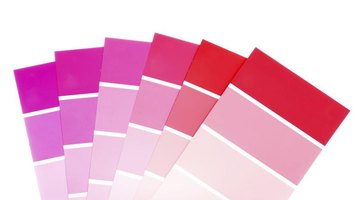Different Names for Shades of Pink
All pink tones start by adding white to red to form tints. Small amounts of white produce medium pink hues such as rose or cerise. Adding more white creates lighter colors such as apple blossom or carnation. Even greater variations of pink result from adding tiny amounts of colors near red on the color wheel to produce cooler tones, which lean toward violet, or warmer tones, which lean toward orange.
Rosy Pinks

Rosy pinks are rooted in basic primary red, modified with white. Their color names are often associated with flowers and delectable treats. Rosy pinks evoke positive emotions and experiences. They have names such as rose, carnation, cherry blossom, apple blossom, bubblegum and cotton candy.
Hot Pinks
Hot pinks describe vivid, highly saturated colors with strong personalities that stimulate excitement.These colors have names such as magenta, fuchsia, cerise, shocking pink, ultra pink and fluorescent pink.
Pinks Leaning Toward Purple
Pinks that derive from a red that has a bit of blue in it tend to lean toward tints of purple; they are quiet, serene and slightly reclusive in feeling. These hues carry names such as lavender, orchid, mauve, wisteria, raspberry and amethyst.
Pinks Leaning Toward Orange
Pinks leaning toward orange on the basic color wheel derive from a red that has a little bit of yellow in it. These pinks have a warm glow that promotes conviviality and are effective in promoting a hospitable feeling in a space. Their names include coral, salmon, peach, melon, Congo pink and amaranth.
Pale Pastel Pinks
Very light pinks formed by adding large amounts of white to red are called pastels. These colors create a soft, airy effect. Their names include misty rose, baby pink, biscuit, shell pink, powder pink and pink lace.
Brownish Pinks
When pink combines with a complementary green (red’s complement, directly across from it on the color wheel), the original color becomes less intense and the result is a browner version of pink such as puce. Pink hues formed by adding white to a low-intensity red hue such as brick or mahogany also produce rich colors that work as interesting neutrals. In addition to puce, names for these colors include vanilla cream, dusty rose, fading rose, dusk, pinky beige and shadowy pink.
-
Technically, a shade is defined as a mixture of black with a color; however, this collection of names includes all versions of pink, with or without the addition of black. Pinks deepened with any amount of black become grayer, as black combines with the white already present in a pink tone to become a less bright, more muted hue. Examples of color names in this group are taupe, putty and cocoa.
References
Resources
Writer Bio
Melanie Aves has more than 30 years writing experience. Aves coauthored four interior design color books, authored a book on Newport Beach, California, wrote newspaper features and currently writes monthly magazine features. She holds a Master of Arts degree, a certificate in interior design, and completed post-graduate studies in journalism.
Photo Credits
- Michael Gray/iStock/Getty Images
More Articles



